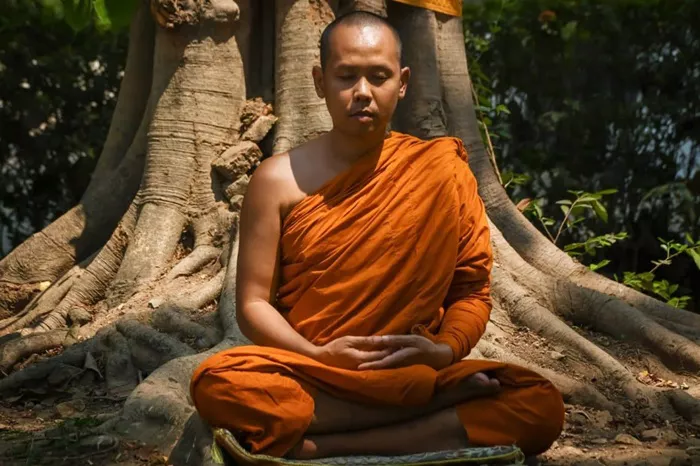Fasting is a practice that many Buddhist monks follow to help control their desires and improve their meditation. It is not about punishment but about discipline and mindfulness. Through fasting, monks learn to understand their body and mind better.
In Buddhism, fasting is connected to spiritual growth. It helps monks focus on their inner world rather than on physical needs. This article explains how Buddhist monks practice fasting, the important dates they follow, and the customs involved.
Why Do Buddhist Monks Fast?
Spiritual Purification
Fasting cleans the body and mind. Monks believe that by fasting, they remove greed, anger, and ignorance. These are the main causes of suffering in Buddhism.
Developing Self-Control
By fasting, monks train their willpower. They learn not to give in to cravings or comfort. This helps them stay calm and peaceful.
Improving Meditation
A light stomach helps monks sit still for long periods. It also makes their mind sharper and more focused.
Types of Fasting Practiced by Buddhist Monks
Intermittent Fasting
Most Buddhist monks eat only before noon. After midday, they do not eat solid food until the next morning. This is the most common fasting method.
Complete Fasting
On special occasions, some monks may fast completely for one or more days. During this time, they only drink water or herbal tea.
Partial Fasting
Sometimes monks reduce the amount of food they eat instead of stopping completely. This helps them practice moderation.
Important Dates for Fasting in Buddhism
Uposatha Days
Uposatha is the Buddhist Sabbath. It happens four times every lunar month, on the new moon, full moon, and quarter moon days.
On these days, monks follow strict fasting rules. They often avoid food after noon and spend more time in meditation and chanting. Lay followers may also fast or practice extra good deeds.
Vassa: The Rains Retreat
Vassa is a three-month retreat during the rainy season. Monks stay in one place and practice intensively.
During Vassa, monks follow stricter fasting rules. They often reduce meals and focus on spiritual growth. Laypeople also support monks by giving alms in the morning.
Magha Puja Day
This important festival celebrates the Buddha’s teachings. Monks may fast on this day as part of their devotion. They practice meditation and follow the precepts strictly.
Asalha Puja Day
This day marks the Buddha’s first sermon. Monks observe fasting and spend time in study and meditation.
Customs and Rules During Fasting
Eating Only Before Noon
Buddhist monks traditionally eat only in the morning before midday. After this time, they do not eat solid food until the next day. This helps them keep discipline and reduce cravings.
Respecting Alms Food
Monks rely on alms food offered by laypeople. They accept what is given without choice. Fasting also means not wasting food and being grateful.
Mindful Eating
When monks eat, they do so slowly and carefully. They think about the effort behind the food and how it supports their practice.
Drinking and Fasting
Some monks drink only water during fasting days. Herbal teas may also be allowed depending on the tradition.
Fasting and Daily Life of Buddhist Monks
Morning Alms Round
Monks begin their day with an alms round. They walk quietly to receive food from laypeople. This meal is their only solid food of the day.
Afternoon and Evening
After eating in the morning, monks spend their time in meditation, chanting, and study. They avoid eating to keep their mind clear and body light.
Balance of Fasting and Health
Monks are careful not to harm their health. If fasting causes weakness, they may adjust their practice. The goal is to balance spiritual discipline with physical well-being.
How Fasting Connects to Buddhist Teachings
The Middle Way
Buddhism teaches the Middle Way, avoiding extremes. Fasting is a way to practice this balance — not too much, not too little.
Detachment from Desire
Fasting helps monks detach from desires. This is important because desire leads to suffering. By controlling hunger, monks learn to control other cravings.
Compassion and Gratitude
Fasting also teaches compassion. Monks understand the suffering of others who lack food. It makes them more grateful for what they have.
Fasting in Different Buddhist Traditions
Theravada Tradition
Theravada monks strictly follow the rule of eating before noon. They often fast on Uposatha days and during Vassa retreat.
Mahayana Tradition
Mahayana monks may practice fasting less strictly. Some fast on special festival days or during meditation retreats.
Vajrayana Tradition
In Vajrayana Buddhism, fasting can include additional rituals. It supports deep meditation and tantric practices.
Additional Buddhist Practices Related to Fasting
Observing Precepts
Fasting days are also times to observe the Eight Precepts more strictly. These precepts include no eating after noon, no entertainment, and no luxurious beds.
Meditation and Chanting
Monks increase meditation and chanting during fasting periods. This helps deepen their spiritual practice.
Community Support
Laypeople support monks by preparing simple food and giving alms. Fasting is a shared practice that builds a strong community.
Conclusion
Fasting is more than just abstaining from food for Buddhist monks. It is a way to train the mind, develop patience, and grow closer to enlightenment. Through fasting, monks learn to control their desires, focus their thoughts, and deepen their meditation practice. The important fasting days and customs remind monks of the Buddha’s teachings and help them live a simple, mindful life.
This practice shows how discipline and compassion go hand in hand in Buddhism. Fasting encourages not only self-restraint but also gratitude for the food and support given by others. In this way, fasting is a powerful tool that supports both personal growth and community harmony within the Buddhist monastic tradition.

